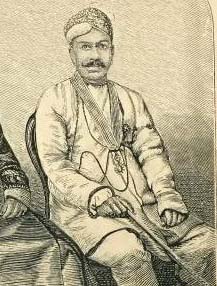- T. Madhava Rao
Infobox Officeholder
honorific-prefix = Rajah, Sir
name = T. Madhava Rao
honorific-suffix = KCSI

imagesize =250px
small
caption = "Portrait of Sir T. Madhava Rao"
order =Dewan ofTravancore
office =
term_start = 1857
term_end =May 1872
vicepresident =
viceprimeminister =
deputy =
lieutenant =
monarch =Uthram Thirunal ,Ayilyam Thirunal ofTravancore
president =
primeminister =
governor =
governor-general =
governor_general =
succeeding =
predecessor =
successor =Seshayya Sastri
constituency =
majority =
order2 =
office2 =
term_start2 =
term_end2 =
vicepresident2 =
viceprimeminister2 =
deputy2 =
lieutenant2 =
monarch2 =
president2 =
primeminister2 =
governor2 =
succeeding2 =
predecessor2 =
successor2 =
constituency2 =
majority2 =birth_date = 1828
birth_place =
death_date = 1891
death_place =
nationality =
party =
spouse =
relations =
children =
residence =
alma_mater =Madras University
occupation =lawyer ,Administrator
profession =Statesman
religion =Hindu
website =
footnotes =T. Madhava Rao ( 1828 to
April 4 ,1891 ), Indian Statesman, born at Cambaconum inMadras Presidency , son of a Dewan ofTravancore .Early Life and Career
Madhava Rao belonged to a
Maratha family that belonged, orginally, toTanjore . His great grandfather Gopal Pant and his grandfather, Gundo Pant, held offices of trust and power under the British as also various Indianprince s. His paternal uncle Rai Raya Rai Venkatta Rao was a formerDewan ofTravancore and later even his father Ranga Rao became the Premier of Travancore, although only for a short while. Madhava Rao had two older brothers.He studied at the Madras High School where he displayed great intelligence. In 1856 he received his First Class Degree and the very next year he secured an appointment in the Accountant-General of Madras's office. He held this post for two years. In 1848 he was appointed at the suggestion of the Resident of
Travancore as tutor to the nephews of MaharajahUthram Thirunal , namely the later MaharajahsAyilyam Thirunal andVisakham Thirunal . In 1853 he was appointed an officer in the Revenue Department of Travancore. In 1855 Madhava Rao, having displayed great capability in his work, was appointed to the high position of Dewan Peishkar, directly under the Dewan. He was deputed as the Peishkar of the Southern Division of the state under the Dewan.In November 1857 the Dewan of
Travancore died and Madhava Rao who was just entering his thirtieth year was appointed Dewan of Travancore by MaharajahUthram Thirunal .Dewan of Travancore
At that time the entire administration of the state was in a disorganized state, public treasuries were empty and large arrears of payments in way of salaries and otherwise were pending. The Maharajah had already taken a loan from the
Sri Padmanabhaswamy Temple ofTrivandrum and adding the subsidy to be paid to the British Government, the state of affairs was bad enough to deter anyone from taking up the post of Dewan. Soon after Madhava Rao's appointment the Shanar agitations took place in Travancore which added to the problems of the state.In 1860 however, the orthodox Maharajah died and Madhava Rao's own pupil, the late Maharajah's nephew,
Ayilyam Thirunal succeeded. Under the new and relatively less orthodox Maharajah Madhava Rao's administration started its progress. Monopolies, numerous petty taxes and cessations were abolished and land tax was reduced. By 1863 the debts of the Travancore Government were cleared and the Dewan proudly declared that "Travancore has no public debt now". Salaries of public servants were raised by more than 50 percent and its morale and efficiency was improved. Madhava Rao's progressive financial measures were testified by the fact that when he assumed the office of Dewan he had an indebted and empty treasury whereas when he left the state in 1872 the state had a reserve fund of forty lakhs of rupees, a great amount in those days.While Madhava Rao is described essentially as a financier, he also brought a great deal of development in Education, legislation, public works, medicine, vaccination and public health, agriculture etc. Year after year his work was commended by the Madras Government. He also drew up State papers on special subjects such as Boundary disputes, trade reports and so on and started maintaining records of every department. In recognition of his services, by public subscription, a bronze statue of Madhava Rao was erected in Travancore.
However misunderstandings rose between the Dewan and the Maharajah. So much was the Maharajah's hatred for his Dewan and former tutor that Madhava Rao himself became personally obnoxious to the Maharajah and in February 1872 he retired. The Maharajah, however, respected his work and granted him a pension of Rs. 1000, a princely amount in those days. His initial plan was to retire to
Madras but instead there was great demand for his services among the Princes of India, because of his having secured forTravancore the appellation of "Model State of India" by the British Government. Sir Henry Fawcett described, on hearing of his retirement in 1872, Madhava Rao as:Later Career and Demise
In 1873 Madhava Rao accepted the office of Dewan offered by the Maharajah
Holkar ofIndore and held that position for a period of two years. From 1875 to 1882 he became the Dewan-Regent ofBaroda State during the minority ofMaharaja Sayajirao Gaekwad III and left that state when the Maharajah assumed full powers in 1882. In both Indore and Baroda, he organized the administration which was, at the time of his appointment, in chaos.He then retired from service and returned to
Madras and died peacefully atMylapore at the age of sixty three in 1891. During his nine years of retirement he occupied himself with the congenial study of Herbert Spencer's works and writing articles for various newspapers, for topics ranging from the German occupation of Africa to the hairstyles to be adopted by boys and girls in schools.Titles and Awards
* Fellow of the Madras University- 1862
* Knight Commander of the Order of the Star of India- 1866
* Title ofRajah - 1868References
*1911
*Travancore State Manual by V. Nagam Aiya, Vol II, pages 559-568
Wikimedia Foundation. 2010.
